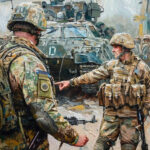Tariffs Aren’t Enough to Bring Back the Glory Days of U.S. Manufacturing

Tariffs Aren’t Enough to Bring Back the Glory Days of U.S. Manufacturing
Job security and economic benefits came about because of unions.
Temporary television antenna is adjusted by a worker from US Steel’s American Bridge Company atop the Empire State Building in New York on Oct. 26, 1950. United States Steel Corporation/AFP via Getty Images
U.S. President Donald Trump has built an entire economic agenda around a promise to revive the standing that American manufacturing once held in the 1940s and 1950s. Dismissing recent attention on green industry and semiconductors, the president is deploying a massive set of tariffs—on adversaries and allies alike—and promising workers that he will restore the country to where it was back in the 1940s and 1950s.
Before he sent the global economy into turmoil on his so-called “Liberation Day,” Trump promised that “April 2, 2025, will forever be remembered as the day American industry was reborn, the day America’s destiny was reclaimed, and the day that we began to make America wealthy again.”
U.S. President Donald Trump has built an entire economic agenda around a promise to revive the standing that American manufacturing once held in the 1940s and 1950s. Dismissing recent attention on green industry and semiconductors, the president is deploying a massive set of tariffs—on adversaries and allies alike—and promising workers that he will restore the country to where it was back in the 1940s and 1950s.
Before he sent the global economy into turmoil on his so-called “Liberation Day,” Trump promised that “April 2, 2025, will forever be remembered as the day American industry was reborn, the day America’s destiny was reclaimed, and the day that we began to make America wealthy again.”
Thus far, the rollout has not exactly worked that way. After more than a trillion dollars in wealth were destroyed within days, Trump ultimately backed away from his threats. Other than his levies on China, the president temporarily paused most of the high tariffs. He promised to revisit them after giving other countries time to negotiate deals. Making even more concessions, Trump then exempted smartphones, computers, and chips from the program.
If the other tariffs do go into effect, most economists doubt that they will be able to bring manufacturing back to the United States. The supply chains and production systems that are at the heart of the modern economy can’t be rebuilt with such speed. Nor is the United States investing in the knowledge-based research and skills needed to make such plants work.
And even if the economic wisdom is wrong, and the tariffs miraculously sprouted up factories across the United States, the president is missing—or more accurately, ignoring—a key ingredient of what made life so great for working and middle-class Americans in the 1940s and 1950s: unions.
The presence of bountiful manufacturing in the United States was not the sole reason that labor thrived. Rather, the hard work that produced substantive collective bargaining agreements generated the economic benefits and job security that are so desperately sought by large swaths of the electorate today.
Seventy-five years ago, the power of labor was on display in Michigan. On May 23, 1950, the United Autoworkers and General Motors signed a historic collective bargaining agreement that journalist Daniel Bell called the “Treaty of Detroit” in Fortune magazine.
During the decades leading up to the agreement, the role of organized labor in the U.S. economy had been vastly expanding. While the American Federation of Labor (AFL) had established itself by early in the 20th century as a champion for trade workers, the Congress of Industrial Organizations (CIO) took form during the New Deal era to represent the millions of shopfloor workers who were building products such as automobiles that fueled the consumer economy.
The CIO organized workers across industries rather than trade. The union emerged after Congress passed the Wagner Act of 1935, which guaranteed workers the right to organize and required employers to enter into negotiations over collective bargaining agreements. As a result of the legislation, businesses could not engage in practices that stifled unions. It also established the National Labor Relations Board to enforce the legislation. The United Auto Workers (UAW) was also officially established the same year that New York Sen. Robert Wagner pushed his legislation to President Franklin Delano Roosevelt’s desk.
In the two decades following the Wagner Act’s passage, labor reached the height of its political power. More than 30 percent of the workforce would be organized by the end of the 1950s.
With their newfound muscle, unions pressured businesses into improving the lives of workers within the factories. In 1945 and 1946, there was a massive wave of strikes as the country converted back from war to peace, with inflation raising prices for most working families.
Not only did the UAW and other unions want pay hikes and improved benefits, but they were also determined to obtain a bigger role in managerial decisions. For instance, UAW President Walter Reuther insisted that GM CEO Charles Wilson was hiding massive profits to avoid granting workers a better deal. Reuther wanted management to be required to open their books.
Achieving success was a constant struggle. Business leaders resisted and fought these demands. After Republicans regained control of Congress in the 1946 midterm elections, the House and Senate passed the Taft-Hartley Act the following year, overriding President Harry Truman’s veto. A devastating blow to unions, the legislation altered the definition of “unfair labor practices” to include some union activity and outlawed certain kinds of tactics, such as secondary boycotts and wildcat strikes. Closed shops—places of work only open to union members—were prohibited. States were granted the authority to enact so-called right-to-work laws, which prevented unions from mandating that workers in certain facilities had to join their organizations. The Taft-Hartley Act will “fail to achieve industrial stability because it is a negative approach to a approach to problems that require positive solution,” Reuther said, “in a society of free men labor-capital peace is possible only if the working people can achieve economic security and social justice for themselves and their families.”
Reuther, who had once been a member of the Socialist Party, decided to purge alleged communist sympathizers from his union’s ranks in an effort to shore up the union’s political standing. He came under intense criticism from many on the left, including some of his allies, for giving in to the right-wing anti-communist pressures of the era.
While Reuther and other union leaders failed to make GM open their books or strengthen labor’s role in managerial decisions, the UAW secured a series of collective bargaining agreements in the following few years of negotiations. In 1947, Ford agreed to provide higher wages. In 1948, General Motors agreed to provide UAW workers with a form of cost-of-living adjustments (COLAs) so that wages could keep up with prices. Reuther also secured health insurance and pension plans. In 1949, Ford agreed to a contract that provided workers who had been at the company for 30 years to receive $100 a month from a fully funded pension plan. To end a strike, Chrysler agreed to do the same the following year.
Continued strikes and negotiations culminated in what Bell, the aforementioned Fortune journalist and future sociologist, would call the “Treaty of Detroit” in May 1950.
The landmark agreement provided for a five-year contract (which GM insisted on to assure several years of stability). In exchange for the UAW agreeing that it would not go on strike or demand renegotiating the terms, GM provided annual wage increases above the COLAs as well as a funded pension plan. The agreement, according to Reuther’s biographer Nelson Lichtenstein in Walter Reuther: The Most Dangerous Man in Detroit, “represented the greatest economic gain won by any of the big unions since before the war.”
Reuther called the deal a “historic agreement” and boasted that it was “the most significant development in labor relations since the mass production industries were organized” in 1936-1937. Then-U.S. Labor Secretary Maurice Tobin argued that the contract meant “there is confidence in the future prosperity of this industry, in its ability to produce so efficiently that it can continue to pay higher wages and, at the same time, to ensure greater security for its workers when they are ill or retire.”
To be sure, the Treaty of Detroit came under considerable criticism. There remained concerns (to this day) that the focus on collective bargaining weakened the resolve of unions—the most powerful element in the Democratic Party’s coalition—to fight for a more robust federal government. Lichtenstein writes that by the 1960s, many workers felt as if they were paying a “double tax”—giving money both to the government and unions, making them less supportive of the struggle that other liberal groups were conducting to achieve security for all.
Moreover, as Lichtenstein argues in his book, the deal was a bad long-term bargain for labor, given that it left workers disempowered relative to managers.
Yet, with all the flaws, the agreement was essential to workers enjoying an improved quality of life. The Treaty of Detroit became the foundation for future agreements with incremental expansions of benefits (such as the introduction of early retirement benefits in 1964). Despite the five-year deal, GM grudgingly agreed in 1953 to renegotiate following the end of the Korean War, when wildcat strikes stopped production. UAW workers obtained a wage increase, an improved cost-of-living structure, and better pensions.
The era of “Grand Expectations” in the 1950s and 1960s, as the historian James Patterson called it in his 1997 book of the same name, depended on the impact of unions. Without their presence, the same factories could easily have continued to operate as exploitatively as they had earlier in the century. Salaries could have been meager, shopfloor dangers immense, and long-term provision nonexistent.
The favorable conditions for industrial workers started to deteriorate in the 1970s and 1980s, when manufacturing moved to the nonunionized, deregulated American South and then overseas. The United States’ newer areas of economic strength—such as high-tech industry the service sector, and finance—were sectors where unions were weak or nonexistent. Then came the 1990s, when the North American Free Trade Agreement accelerated many of the trends that inhabitants of the Rust Belt had been experiencing since the time that President Richard Nixon stepped down from office.
In recent debates, there has been a stunning myopia about the vital role that organized labor played in securing the era that Trump waxes nostalgic about. To some extent, many Democrats who prioritize limited tariffs and public investment in new forms of manufacturing also downplay this.
For all the criticism of the collective bargaining regime—whether from the left, for the effect of weakening working class support for the welfare state, or the right, for increasing costs on business—it is impossible to ignore just how crucial organization was to middle-class economic security of the 20th century.
Indeed, not only does the Trump administration ignore this pivotal component of the “American Century,” but it has also been extraordinarily hostile toward labor. One of Trump’s first moves on starting his second term was to fire National Labor Relations Board member Gwynne Wilcox, appointed by former President Joe Biden. This move rendered the government body incapable of taking any action since its five members were down to two, short of a quorum. (A federal court ruled in early March that the firing had been “a blatant violation of the law”; the Trump administration has appealed the decision, and the case may make its way to the Supreme Court.)
The administration has also reduced the enforcement efforts of the Office of Safety and Health Administration (OSHA). Trump’s newly created Department of Government Efficiency has fired thousands of federal workers. The New York Times reported that the administration is seeking to end a rule that protects miners from inhaling dangerous fumes as well as Labor Department regulations that expanded the number of workers who could receive crucial benefits such as sick leave and overtime pay.
The Republican budget is also going after benefits, such as Medicaid, that many workers and their families depend on. Government agencies such as OSHA have become Trump advisor Elon Musk’s brutal campaign targets. Actual policies that would help working families—such as a higher minimum wage, subsidized child care, and college tuition assistance—do not seem to be of interest to the administration. From all accounts, the administration’s slew of tariffs will cause more harm than good.
The factories that take form in the United States will not inevitably be filled with workers who would enjoy the economic protections that Trump is promising. In many of those facilities, robots might end up doing the work.
Empowering U.S. workers will require an administration that stands behind organized labor. Even if the factories are somehow built, having them filled with robots and workers who can’t count on adequate protections or payments will not add up to much.
This post is part of FP’s ongoing coverage of the Trump administration. Follow along here.
Julian E. Zelizer is a columnist at Foreign Policy and a professor of history and public affairs at Princeton University. His most recent book, In Defense of Partisanship, is published with Columbia Global Reports. He is the author of The Long View, a newsletter putting the news in perspective. X: @julianzelizer
More from Foreign Policy
-

U.S. President Donald Trump gives a thumbs-up upon arrival at Joint Base Andrews in Maryland after spending the weekend at Mar-a-Lago. How to Ruin a Country
A step-by-step guide to Donald Trump’s destruction of U.S. foreign policy.
-

Chinese President Xi Jinping arrives for a meeting with Vietnamese National Assembly Chairman Tran Thanh Man in Hanoi on April 14. Why Beijing Is Standing Up to Trump
Chinese leaders have their pride, too.
-

Russian soldiers practice marching Why Don’t Russian Soldiers Revolt?
Astonishing death rates and brutal abuse have not kept troops from following orders.
-

An illustration shows a police officer trying to sudue a panicked mob of men. The Awful History of Tariffs and Depressions
What the 19th century teaches us about what happens next.











Join the Conversation
Commenting on this and other recent articles is just one benefit of a Foreign Policy subscription.
Already a subscriber?
.
Subscribe
Subscribe
View Comments
Join the Conversation
Join the conversation on this and other recent Foreign Policy articles when you subscribe now.
Subscribe
Subscribe
Not your account?
View Comments
Join the Conversation
Please follow our comment guidelines, stay on topic, and be civil, courteous, and respectful of others’ beliefs.
Change your username |
Log out
Change your username:
CANCEL
Confirm your username to get started.
The default username below has been generated using the first name and last initial on your FP subscriber account. Usernames may be updated at any time and must not contain inappropriate or offensive language.